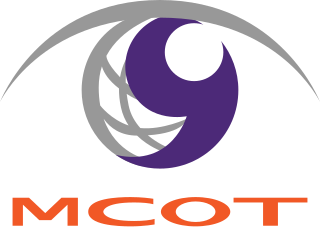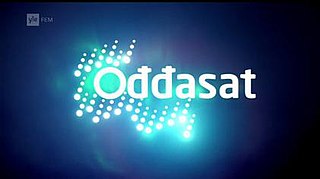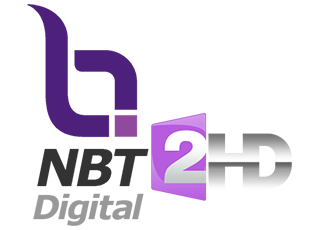Telecommunications in Paraguay are meager. Paraguay has the lowest fixed-line telephone density in South America, with 5.6 lines per 100 residents, compared with 8.7 per 100 in Bolivia, 21.9 in Brazil, and 24.9 in Argentina.
A television broadcaster or television network is a telecommunications network for the distribution of television content, where a central operation provides programming to many television stations, pay television providers or, in the United States, multichannel video programming distributors. Until the mid-1980s, broadcast programming on television in most countries of the world was dominated by a small number of terrestrial networks. Many early television networks such as the BBC, CBS, CBC, NBC or ABC in the US and in Australia evolved from earlier radio networks.
Public broadcasting involves radio, television, and other electronic media outlets whose primary mission is public service. Public broadcasters receive funding from diverse sources including license fees, individual contributions, public financing, and commercial financing, and avoid political interference or commercial influence.
Channel 7 or TV7 may refer to:
Channel 9 or TV 9 may refer to:
Religious broadcasting, sometimes referred to as faith-based broadcasts, is the dissemination of television and/or radio content that intentionally has religious ideas, religious experience, or religious practice as its core focus. In some countries, religious broadcasting developed primarily within the context of public service provision, whilst in others, it has been driven more by religious organisations themselves. Across Europe and in the US and Canada, religious broadcasting began in the earliest days of radio, usually with the transmission of religious worship, preaching or "talks". Over time, formats evolved to include a broad range of styles and approaches, including radio and television drama, documentary, and chat show formats, as well as more traditional devotional content. Today, many religious organizations record sermons and lectures, and have moved into distributing content on their own web-based IP channels.
Channel 4 is a British television station, operated by the Channel Four Television Corporation.

Radiotelevizija Slovenija – usually abbreviated to RTV Slovenija – is Slovenia's national public broadcasting organization.

MCOT Public Company Limited, formerly known as the Mass Communication Organization of Thailand, is a Thai state-owned public broadcaster. It owns and operates a number of radio and television stations in Thailand. It is based in Bangkok.
Te Kāea is a nightly New Zealand television news show that airs on Whakaata Māori at 6:30pm. It is repeated at 10:30pm, and has English subtitles. Te Kāea is also shown in Australia, helped by Whakaata Māori's "strong collaborative relationship" with Australia's NITV as members of the World Indigenous Television Broadcasters Network (WITBN).

Ođđasat is a Sámi television news programme broadcast in Norway, Sweden and Finland. Jointly produced by NRK, SVT and Yle, the public service broadcasters in their respective countries, the programme is presented from NRK's studio in Norway. When the production of the programme began, its titles and graphics were different from NRK's domestic television news bulletins. In around 2008, the programme saw a new look; while it still differed from the revamped look of the rest of NRK's bulletins at the time, the lower thirds were set in the same grid of graphics that NRK's bulletins used. It also utilised the Neo Sans typeface for its presentation. In mid-2015, about a month after NRK's domestic bulletins revamped their look, Ođđasat followed with the new NRK news intro corporate look and theme music.

NRK Sápmi is a unit of the Norwegian Broadcasting Corporation (NRK) that streams news and other programs in the Sámi languages for broadcast to the Sami people of Norway via radio, television, and internet. Regular radio news programs in Sami began in 1946, presented from Tromsø by the teacher Kathrine Johnsen (1917–2002), remembered today as "Sami Radio's Mother".

The Aboriginal Peoples Television Network is a Canadian specialty channel. Established in 1992 and maintained by governmental funding to broadcast in Canada's northern territories, APTN acquired a national broadcast licence in 1999. It airs and produces programs made by, for and about Indigenous peoples in Canada and the United States. Based in Winnipeg, Manitoba, it is the first network by and for North American indigenous peoples.
In Thailand, television broadcasting started on 24 June, 1955. Color telecasts were started in 1967, and full-time color transmissions were launched in 1975. As of November 2020, there are currently 21 digital (DVB-T2) TV channels in Thailand.

National Broadcasting Services of Thailand (NBT) is the public broadcasting arm of the Government Public Relations Department (PRD), a division of the Thai Government. It operates comprehensive media services comprising radio, public television networks, online services and social media.

Channel 9 MCOT HD is a Thai state-owned free-to-air television network launched on 24 June 1955. It is owned by MCOT.
Unna Junná is a children's television program produced by Finnish public broadcaster Yle Sámi Radio several different Sámi languages. It was the first Sámi-language children's program on Finnish TV and it now airs in Northern, Inari, and Skolt Sámi languages. Since 2007, Unna Junná has aired on Yle and SVT television channels in Finland and Sweden respectively.
Sameradion is the Sámi languages radio department of Swedish public service broadcaster Sveriges Radio (SR). Sameradion provides news, current affairs, cultural, sports, entertainment, and children’s programming for Sámi across Sweden.






